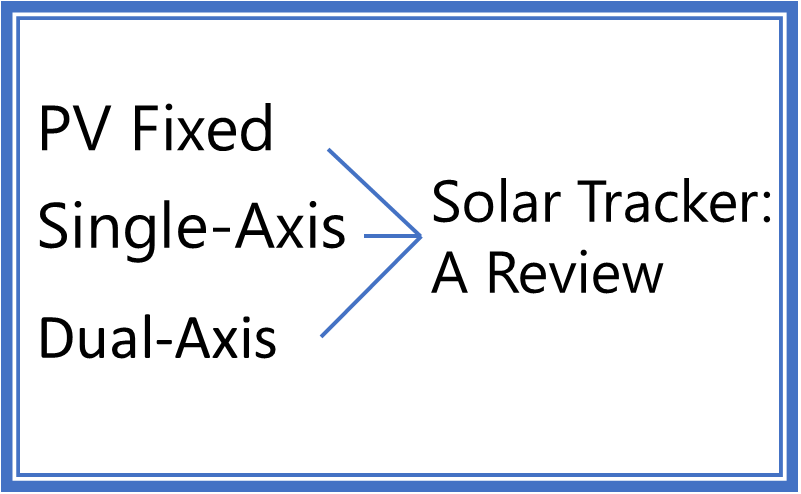Comparison of the Efficiency of Solar PV Fixed, Single-Axis, and Dual-Axis Solar Trackers: A Review
DOI:
https://doi.org/10.21009/JKEM.10.1.9Keywords:
solar PV; solar tracker; efficiencyAbstract
The global energy shortage, especially in developing countries, drives the search for alternative energy sources such as solar power, which is one of the cleanest energy sources. This research discusses the comparison of efficiency between solar PV fixed, single-axis solar trackers, and dual-axis solar trackers. The method used is a survey of the literature of multiple studies that only analyzes the efficiency of solar PV using different tracking devices. The efficiency data is normalized based on location factors and light intensity for a fair comparison. The results show that fixed solar panels are stationary and simple, serving as a baseline with 100 % efficiency. Single-axis panels track the sun horizontally, boosting efficiency by 25.6 % but with moderate complexity due to motors and controls. Dual-axis panels track the sun both horizontally and vertically, increasing efficiency by up to 50 % but with the highest complexity due to more moving parts and dual-axis control systems.
References
[1] J. Wang and W. Azam, “Natural resource scarcity, fossil fuel energy consumption, and total greenhouse gas emissions in top emitting countries,” GSF, vol. 15, no. 2, 2024, doi: 10.1016/j.gsf.2023.101757.
[2] M. Abdel-Basset, R. Mohamed, S. Mirjalili, R. K. Chakrabortty, and M. J. Ryan, “Solar photovoltaic parameter estimation using an improved equilibrium optimizer,” J. Solener, vol. 209, pp. 694–708, 2020, doi: 10.1016/j.solener.2020.09.032.
[3] N. Utomo, H. Johan, and R. W. Wardana, “Analisis potensi daya listrik dari cahaya matahari menggunakan panel surya jenis polycristaline di kawasan pesisir dan dataran tinggi provinsi bengkulu,” J. Kumparan Fis., vol. 5, no. 3, pp. 181–186, 2023, doi: 10.33369/jkf.5.3.181-186.
[4] Y. P. Sibagariang, H. V. Sihombing, E. Y. Setyawan, K. Kishinami, and H. Ambarita, “The potency of solar energy on medan city of indonesia: comparison of clear sky, satellite and field measurements,” in AIP Conf. Proc., vol. 2221, 2020, doi: 10.1063/5.0003482.
[5] A. Awasthi, A. K. Shukla, M. M. S. R., C. Dondariya, K. N. Shukla, D. Porwal, and G. Richhariya, “Review on sun tracking technology in solar PV system,” Energy Rep., vol. 6, pp. 392-405, 2020, doi: 10.1016/j.egyr.2020.02.004.
[6] M. M. Fouad, L. A. Shihata, and E. I. Morgan, “An integrated review of factors influencing the perfomance of photovoltaic panels,” Renew. Sustain. Energy Rev., vol. 80, pp. 1499-1511, 2017, doi: /10.1016/j.rser.2017.05.141.
[7] R. Vinodhkumar and S. John, “IoT based dual-axis solar tracking system,” in IOP Conf. Series: Materials Science and Engineering, vol. 913, 2020, doi: 10.1088/1757-899X/912/3/032024.
[8] S. L. Gbadamosi, “Design and implementation of IoT-based dual-axis solar PV tracking system,” Przeglad Elektrotechniczny, vol. 97, no. 12, pp. 57–62, 2021, doi: 10.15199/48.2021.12.09.
[9] F. J. Gómez‐uceda, J. Ramirez‐faz, M. Varo‐martinez, and L. M. Fernández‐ahumada, “New omnidirectional sensor based on open‐source software and hardware for tracking and backtracking of dual‐axis solar trackers in photovoltaic plants,” Sensors, vol. 21, no. 3, p. 726, 2021, doi: 10.3390/s21030726.
[10] A. S. Al-Ezzi and M. N. M. Ansari, “Photovoltaic Solar Cells: A Review,” Appl. Syst. Innov., vol. 5, no. 4, p. 67, 2022, doi: 10.3390/asi5040067.
[11] A. B. Pulungan, R. Risfendra, W. Purwanto, H. Maksum, and O. Setiawan, “Design and development of real time monitoring single axis solar tracker by using internet of things,” Int. J. GEOMATE, vol. 18, no. 69, pp. 81–87, 2020, doi: 10.21660/2020.69.25863.
[12] H. D. F. Amaral, A. H. Santoso, P. S. Harijanto, and K. A. Wibisono, “Monitoring sun tracking solar panel statis secara real-time berbasis website,” Elposys, vol. 10, no. 3, pp. 178-182, doi: 10.33795/elposys.v10i3.4418.
[13] H. Wibowo, Y. Bow, and C. R. Sitompul, “Performance comparison analysis of fixed and solar-tracker installed panel at PV system,” in IOP Conf. Series: Earth and Environmental Science, IOP Publishing Ltd, vol. 709, 2021. doi: 10.1088/1755-1315/709/1/012003.
[14] A. Karafil, H. Ozbay, M. Kesler, and H. Parmaksiz, “Calculation of optimum fixed tilt angle of PV panels depending on solar angles and comparison of the results with experimental study conducted in summer in bilecik, turkey,” in 2015 9th International Conference on Electrical and Electronics Engineering (ELECO), pp. 971-976, 2015, doi: 10.1109/ELECO.2015.7394517.
[15] Y. Zhu, J. Liu, and X. Yang, “Design and performance analysis of a solar tracking system with a novel single-axis tracking structure to maximize energy collection,” Appl. Energy, vol. 264, 2020, doi: 10.1016/j.apenergy.2020.114647.
[16] D. D. Alijanov and N. A. o‘g‘li Topvoldiyev, “Solar tracker system using arduino,” Theoretical & Applied Science, vol. 101, no. 09, pp. 249–253, 2021, doi: 10.15863/TAS.2021.09.101.18.
[17] N. Kuttybay, A. Saymbetov, S. Mekhilef, M. Nurgaliyev, D. Tukymbekov, G. Dosymbetova, A. Meiirkhanov, and Y. Svanbayev, “Optimized single-axis schedule solar tracker in different weather conditions,” Energies, vol. 13, no. 19, p. 5226, 2020, doi: 10.3390/en13195226.
[18] S. Gutierrez, P. M. Rodrigo, J. Alvarez, A. Acero, and A. Montoya, “Development and testing of a single-axis photovoltaic sun tracker through the internet of things,” Energies, vol. 13, no. 10, p. 2547, 2020, doi: 10.3390/en13102547.
[19] A. A. Elsayed, E. E. Khalil, M. A. Kassem, and O. A. Huzzayin, “A novel mechanical solar tracking mechanism with single axis of tracking for developing countries,” Renew. Energy, vol. 170, pp. 1129–1142, 2021, doi: 10.1016/j.renene.2021.02.058.
[20] S. Subir, R. A. Susilo, L. H. Gunanto, M. H. Rahmatullah, A. N. Rahman, Y. S. Peli, and R. Y. Dillak, “Solar tracker berbasis arduino uno,” J. Ilmiah Flash, vol. 9, no. 1, pp. 66–69, 2023.
[21] R. Fernandes and M. Yuhendri, “Implementasi solar tracker tanpa sensor pada panel surya,” JTEV, vol. 6, no. 2, pp. 337-343, 2020.
[22] A. Marcu, C. Alexandru, and I. Barbu, “Modeling and simulation of a dual-axis solar tracker for PV modules,” in IOP Conf. Series: Materials Science and Engineering, vol. 514, p. 012036, 2019, doi: 10.1088/1757-899X/514/1/012036.
[23] T. Kanwal, S. U. Rehman, T. Ali, K. Mahmood, S. G. Villar, L. A. D. Lopez, and I. Ashraf, “An intelligent dual-axis solar tracking system for remote weather monitoring in the agricultural field,” Agriculture, vol. 13, no. 8, p. 1600, 2023, doi: 10.3390/agriculture13081600.
[24] M. D. Nugraha, K. A. Mahabojana, and N. A. Prabawa, “Design and build an internet of thing (IOT) solar panel monitoring and solar tracking system,” IRJEIS, vol. 9, no. 4, pp. 99-110, 2023, doi: 10.21744/irjeis.v9n4.2334.
[25] I. I. Y. Panessai, M. M. Lakulu, S. K. A. Subramaniam, A. F. Saad, M. I. M. Damanhuri, and N. I. Yusuf, “Developing a prototype for sun tracker system based on IoT: controlled by mobile app and online database monitoring,” Am. J. Appl. Sci., vol. 16, no. 1, pp. 11–25, 2019, doi: 10.3844/ajassp.2019.11.25.
[26] H. Shang and W. Shen, “Design and implementation of a dual-axis solar tracking system,” Energies, vol. 16, no. 17, p. 2023, doi: 10.3390/en16176330.
[27] S. Racharla and K. Rajan, “Solar tracking system–a review,” Int. J. Sustain. Eng., vol. 10, no. 2, pp. 72-81, 2017, doi: 10.1080/19397038.2016.1267816.
[28] C. Jamroen, P. Komkum, S. Kohsri, W. Himananto, S. Panupintu, and S. Unkat, “A low-cost dual-axis solar tracking system based on digital logic design: design and implementation,” Sustain. Energy Technol. Assessments., vol. 37, p. 100618, 2020, doi: 10.1016/j.seta.2019.100618.
[29] B. A. Hamad and A. M. T. Ibraheem, “Design and implementation of a dual-axis solar tracking system STS,” NTU-JET, vol. 1, no. 1, pp. 35-43, 2021, doi: 10.56286/ntujet.v1i1.84.
[30] B. A. Hamad, A. M. T. Ibraheem, and A. G. Abdullah, “Design and practical implementation of dual-axis solar tracking system with smart monitoring system,” Przeglad Elektrotechniczny, vol. 96, no. 10, pp. 151–155, 2020, doi: 10.15199/48.2020.10.28.
[31] A. Mohamad, H. Mhamdi, N. A. M. Amin, M. Izham, N. A. Aziz, and S. Y. Chionh, “A review of automatic solar tracking systems,” in J. Phys. Conf. Ser., vol. 2051, p. 012010, 2021. doi: 10.1088/1742-6596/2051/1/012010.
[32] M. N. A. Mohd Said, S. A. Jumaat, and C. R. A. Jawa, “Dual axis solar tracker with IOT monitoring system using arduino,” IJPEDS, vol. 11, no. 1, pp. 451–458, 2020, doi: 10.11591/ijpeds.v11.i1.pp451-458.
[33] Y. M. Manu, S. V. Shashikala, M. K. Hemchandru, P. Rachitha, B. N. Kavya, and D. Hongirana, “Single axis solar tracking system,” in 2nd IEEE International Conference on Advances in Information Technology, ICAIT 2024 - Proceedings, 2024. doi: 10.1109/ICAIT61638.2024.10690503.
[34] M. J. Nahar, M. R. Sarkar, M. Uddin, M. F. Hossain, M. M. Rana, and M. R. Tanshena, “Single axis solar tracker for maximizing power production and sunlight overlapping removal on the sensors of tracker,” Int. J. Robot. Control Syst., vol. 1, no. 2, pp. 186–197, 2021, doi: 10.31763/ijrcs.v1i2.333.
[35] X. C. Ngo, T. H. Nguyen, N. Y. Do, D. M. Nguyen, D.-V. N. Vo, S. S. Lam, D. Heo, M. Shokouhimehr, V.-H. Nguyen, R. S. Varma, S. Y. Kim, and Q. V. Le, “Grid-connected photovoltaic systems with single-axis sun tracker: Case study for central Vietnam,” Energies, vol. 13, no. 6, p. 1457, 2020, doi: 10.3390/en13061457.
[36] V. S. Qader, N. I. Hasan, O. M. Ali, “An experimental comparison between fixed and single-axis tracking photovoltaic solar panel performance: zakho city as case study,” AREJ, vol. 28, no.1, pp. 272-279, 2023.
[37] R. Rinaldi, B.S. Aprillia, C. Ekaputri, and M. Reza, “Design of open loop single axis tracker system,” in IOP Conf. Series: Materials Science and Engineering, vol. 982, p. 012016, 2020, doi:10.1088/1757-899X/982/1/012016.
[38] C. Jamroen, C. Fongkerd, W. Krongpha, P. Komkum, A. Pirayawaraporn, and N. Chindakham, “A novel UV sensor-based dual-axis solar tracking system: implementation and performance analysis,” J. A. Energy, vol. 299, p. 117295, 2021, doi: 10.1016/j.apenergy.2021.117295.
[39] V. Mohanapriya, V. Manimegalai, V. Praveenkumar, and P. Sakthivel, “Implementation of dual axis solar tracking system,” in IOP Conf. Series: Materials Science and Engineering, vol. 1084, p. 012073, 2021, doi: 10.1088/1757-899x/1084/1/012073.
[40] P. Siagian and R. Manurung, “Pengembangan panel surya 120 wp dengan solar tracker double axis sebagai bahan pembelajaran mahasiswa di program studi teknik mesin UHN,” Sprocket, vol. 3, no. 2, 2022, doi: 10.36655/sprocket.v3i2.658.
[41] M. Angulo-Calderón, I. Salgado-Tránsito, I. Trejo-Zúñiga, C. Paredes-Orta, S. Kesthkar, and A. Díaz-Ponce, “Development and accuracy assessment of a high-precision dual-axis pre-commercial solar tracker for concentrating photovoltaic modules,” Appl. Sci., vol. 12, no. 5, p. 2625, 2022, doi: 10.3390/app12052625.
[42] S. A. A. Shufat, E. Kurt, and A. Hancerlioğulları, “Modeling and design of azimuth-altitude dual axis solar tracker for maximum solar energy generation,” Int. J. Renew. Energy Dev., vol. 8, no. 1, pp. 7–13, 2019, doi: 10.14710/ijred.8.1.7-13.
[43] M. Alif Ismail, K. A. Ramanathan, M. Hafizi Idris, K. Ananda-Rao, M. Mazlan, and N. Fairuz, “Improving the performance of solar panels by the used of dual axis solar tracking system with mirror reflection,” in J. Phys. Conf. Ser., vol. 1432, p. 012060, 2020. doi: 10.1088/1742-6596/1432/1/012060.
[44] A. Fathi, H. Yousefi, A. Komarizadeh, M. Salehi, K. Choubineh, and L. Ghahremani, “Cost-effective dual-axis solar tracker with enhanced performance,” EEER, vol. 6, no. 3, pp. 1-13, 2022, doi: 10.22097/eeer.2022.316215.1232.
[45] A. M. Yusop, M. A. S. M. Shabri, N. A. Sulaiman, K. N. Khamil, R. Mohammed, and J. M. Sultan, “Development and evaluation of dual axis solar tracking system with IoT data monitoring,” Przeglad Elektrotechniczny, vol. 99, no. 1, pp. 28–32, 2023, doi: 10.15199/48.2023.01.05.
[46] A. R. Amelia, Y. M. Irwan, I. Safwati, W. Z. Leow, M. H. Mat, and M. S. A. Rahim, “Technologies of solar tracking systems: a review,” in IOP Conf. Series: Materials Science and Engineering, vol. 767, p. 012052, 2020. doi: 10.1088/1757-899X/767/1/012052.
[47] S. Ahmad, A. N. Razali, and M. I. Misrun, “Effective and low-cost arduino based dual-axis solar tracker,” in J. Phys. Conf. Ser., vol. 1878, p. 012049, 2021, doi: 10.1088/1742-6596/1878/1/012049.
[48] U. Mamodiya and I. Kishor, “A comparative study on the performance of dual axis solar tracking systems and fixed solar arrays,” in Proceedings of the 5th International Conference on Information Management & Machine Intelligence, pp. 1-4, 2023, doi: 10.1145/3647444.3647943.
[49] M. Ghassoul, “A dual solar tracking system based on a light to frequency converter using a microcontroller,” J. Fue. Co., vol. 6, p. 100007, 2021, doi: 10.1016/j.jfueco.2020.100007.

Downloads
Published
How to Cite
Issue
Section
License
Copyright (c) 2025 Mas Efendi, Rahmat Imam Mainil, Azridjal Aziz

This work is licensed under a Creative Commons Attribution 4.0 International License.





















